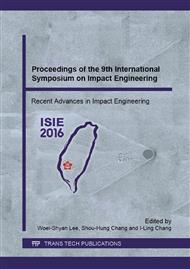p.186
p.192
p.198
p.203
p.210
p.216
p.222
p.231
p.237
Numerical Study of High Velocity Impact onto MMC/Ceramic Layered Systems
Abstract:
Metal Matrix Composites (MMCs) can be applied to military applications due to the light weight and the ballistic performance. In this study, a numerical simulation has been performed for the penetration of a long-rod penetrator into MMC/Ceramic layered systems. The impact velocity is 1.5km/s and the length to diameter (L/D) ratio is 10.6. First, the ballistic performances of each candidate materials are examined by doing the semi-infinite target simulation to estimate the depth of penetration (DOP) data. The materials included in this study are four (tungsten alloy, mild steel, SiC, MMC. The MMC materials are SiC/Al7075 (volume fraction around 45%). For a reference data, the impact simulation into mild-steel target only was also carried out. Finally, the main simulation is performed by varying the position of ceramic tile at three types of the thickness of ceramic tile. The residual velocity, residual mass and residual kinetic energy of the long-rod are obtained from the simulation. Based on these predicted values, the optimum system of the layered plate has been estimated.
Info:
Periodical:
Pages:
210-215
Citation:
Online since:
September 2016
Authors:
Price:
Сopyright:
© 2016 Trans Tech Publications Ltd. All Rights Reserved
Share:
Citation:


